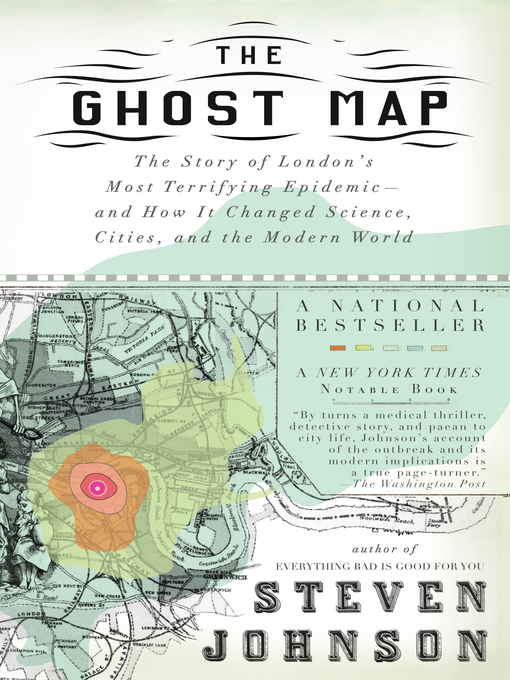
The Ghost Map
The Story of London's Most Terrifying Epidemic--and How It Changed Science, Cities, and the Modern World
داستان وحشتناکترین اپیدمی لندن - - و اینکه چگونه علم، شهرها و دنیای مدرن را تغییر داد
فرمت کتاب
ebook
تاریخ انتشار
2006
Reading Level
10-11
ATOS
11.2
Interest Level
9-12(UG)
نویسنده
Steven Johnsonشابک
9781101158531
کتاب های مرتبط
- اطلاعات
- نقد و بررسی
- دیدگاه کاربران
نقد و بررسی

Starred review from August 21, 2006
On August 28, 1854, working-class Londoner Sarah Lewis tossed a bucket of soiled water into the cesspool of her squalid apartment building and triggered the deadliest outbreak of cholera in the city's history. In this tightly written page-turner, Johnson (Everything Bad Is Good for You
) uses his considerable skill to craft a story of suffering, perseverance and redemption that echoes to the present day. Describing a city and culture experiencing explosive growth, with its attendant promise and difficulty, Johnson builds the story around physician John Snow. In the face of a horrifying epidemic, Snow (pioneering developer of surgical anesthesia) posited the then radical theory that cholera was spread through contaminated water rather than through miasma, or smells in the air. Against considerable resistance from the medical and bureaucratic establishment, Snow persisted and, with hard work and groundbreaking research, helped to bring about a fundamental change in our understanding of disease and its spread. Johnson weaves in overlapping ideas about the growth of civilization, the organization of cities, and evolution to thrilling effect. From Snow's discovery of patient zero to Johnson's compelling argument for and celebration of cities, this makes for an illuminating and satisfying read. B&w illus.

February 26, 2007
The idiosyncratic thinker and cultural historian Johnson leaps from trumpeting video games (in his previous book Everything Bad Is Good for You
) to uncovering the history of murderous cholera infestations in London and the scientific research that revealed the microbial origins of the outbreaks. Sklar reads Johnson's engaging book with a deep, measured baritone that is the embodiment of solidly backed reasonability. Sklar makes each word sound as if it has been chipped into a block of marble, there to rest for all eternity. This is not always conducive to following the flow of Johnson's narrative, but Sklar does well with his voice what Johnson seeks to do with his book: insert a slip into the history book, adding the mundane deaths of working souls and the audacious efforts of scientists into the story of the European march of progress. Simultaneous release with
the Riverhead hardcover (Reviews, Aug. 21).

October 1, 2006
Popular science author, blogger, and Discover magazine columnist Johnson (Everything Bad Is Good for You: How Today's Popular Culture Is Actually Making Us Smarter) has written a fascinating book about a small slice of medical history: London's 1854 cholera epidemic. In particular, he brings to light the contributions of physician John Snow, a pioneer in public health who mapped the route of the disease and whose work continues to have great relevance for the 21st century. Though Johnson graphically describes the causes and effects of cholera, his imagery is not gratuitous, and he quotes historical documents in detail, often paraphrasing them in subsequent paragraphs to make them more understandable. This is a far more readable work on the subject than Margaret Pelling's Cholera, Fever and English Medicine 18251865. Johnson supplies chapter notes, a bibliography, and important information about other related books, e.g., Stephen Halliday's The Great Stink of London and Tom Koch's Cartographies of Disease. This extremely well-researched history is recommended for large public and high school libraries and for any library with history of medicine or public health collections. (Index not seen.) [See Prepub Alert, LJ 6/1/06.]Martha E. Stone, Massachusetts General Hosp. Lib., Boston
Copyright 2006 Library Journal, LLC Used with permission.

Starred review from October 1, 2006
More than two million people were squeezed into 30 square miles in Victorian London, producing massive quantities of waste that, before modern public waste disposal systems, fouled both land and the Thames River. Indeed, Johnson says, "No extended description of London from that period failed to mention the stench of the city." Some, called miasmatists, believed foul odors caused disease. Many believed the lifestyles of the poor and ignorant masses made them more susceptible to illness. Thus, in late summer of 1854, when cholera began claiming poor -working-class residents of the Golden Square neighborhood, popular opinion blamed the city's excavation of a nearby burial ground. But Dr. John Snow, an anesthesia expert and consultant to the queen, and the Reverend Henry Whitehead thought the pathogen might have a different source. Their dogged efforts soon ended the deadly epidemic. They demonstrated that " Vibrio cholerae" had been contracted by drinking contaminated water from the neighborhood pump. In the short run, Snow and Whitehead saved hundreds, perhaps thousands, of lives. In the long run, their work, part of which consisted of mapping the disease's spread, resulted in efficient public waste disposal systems and disease control measures that saved millions worldwide. And that work is hardly done.(Reprinted with permission of Booklist, copyright 2006, American Library Association.)

























دیدگاه کاربران